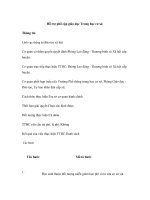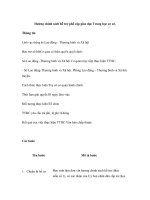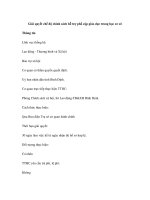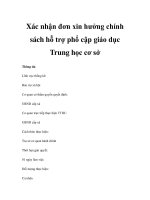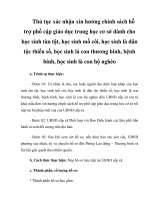KẾ HOẠCH cải CÁCH hỗ TRỢ tài CHÍNH GIÁO dục đại học
Bạn đang xem bản rút gọn của tài liệu. Xem và tải ngay bản đầy đủ của tài liệu tại đây (1.08 MB, 48 trang )
ABSTRACT
In Vietnam, research on the US higher education system has been introduced to the
scholars as well as the public. However, there has been not much research that
intensely focuses on higher education under the time of Barack Obama, especially
after his reelection in 2012. As one of the first attempts, this research paper seeks to
explore the higher education reform plans of President Obama and its details,
implementation and responses, especially on federal financial supports. The paper
begins with reviewing the remarkable features of the US Higher Education system
and important historical legislations that make profound impacts to the US Higher
Education system until today. Then, the investigation involves the legislations and
their implementation under President Obama’s first term 2009-2012 and the reform
plans for the second term 2012-2015. The analyses of the collected data
demonstrate improvements of the President’s plans from previous financial policies;
its strengths and challenges from scholars’ perspectives in order to discuss the
plan’s possibility of success and its impacts.
ii
TABLE OF CONTENTS
!"#$
%& #'()"&#*+&, -%
.)#/#*+&, -%
0+# #$#1-%
2&!)+&!,),!.
%3340
1+! ,)"#&-&+0
5 &!,),!#*++1+! ,)"#2
%)!$5"##*,+#!- !&/#&'$-6
.#&& 7/ ,!&8
%19)&#*++1+! ,)"#!*#!+&#!-+:
%+#!!$$):
%%+!);& (,&):00<)#*=,%%:00>?
%.+1+! ,)"#)<>#*:@2
.-/&#** !$&, &
. !$1!&A&)+#$!&+/&
.% !$$#&.
..4#!BC&, -(#'&.
.0 *#!$!-*$&.
.@
D@
E$/1 $$&&$&F#! #$$1G6
!&8
%#&%?
.+!&,//#!&%0
%ED/1)#&& #HG%@
%#$)&//$ #)#$$1& ,!&"&%@
iii
%%#$)&//$ #&&%6
.+!!*#!/$&%:
.E!1+1+)#,-)#$$1G%:
.%E/!#1!&/!)- ))#,'$-G.
0
(#!9 1&#*+!&!)+
%"#&#*+&, -.0
.,11&"#&*#!*,!+!&, &.0
.2
.:
iv
ACRONYMS
ARRA American Recovery and Reinvestment Act
CCAF Community College of the Air Force
ED The US Department of Education
EFC Expected Family Contribution
FAFSA Federal Student Aid Application
FELFE Federal Family Education Loan
FSEOG Federal Supplemental Educational Opportunity Grant
HCERA Health Care and Education Reconciliation Act
HEA Higher Education Act
IBR Income-Based Repayment
PLUS Parent Loan for Undergraduate Students
TAACCCT Trade Adjustment Assistance Community College and Career
Training
TEACH A Teacher Education Assistance for College and Higher Education
v
LIST OF TABLES, FIGURES, AND CHARTS
TABLES PAGE
Table 1 The US postsecondary institutional classification system 6
Table 2 Federal loans system under FELFE program 13
Table 3 Federal loans system under HCERA 22
vi
CHAPTER 1: INTRODUCTION
1. Statement and rationale
In such a leading country as the United States of America, higher education
takes pervasive roles because “the system has generated tremendous scientific
discoveries, fueled the economy, solved pressing social problems, and ensured the
cultural vitality in our [America’s] community” (Rosenstone, 2004). Moreover,
access to higher education can bring tremendous opportunities to all kinds of people
in America to realize their dreams and to move forward in their lives. Millions of
students with postsecondary education can make tremendous contribution to their
families and communities.
The United States of America, which is home of the biggest and first-rated
universities and colleges in the world, attracts millions of student all over the
country and the world to come to study and do research every year. One thought-
provoking question is how the US Government can run this giant system effectively
and what are the efficacious educational incentives that they offer to support and
encourage the development of universities and colleges. Moreover, in the era of
economic crisis and international affairs, will the educational policies be placed as
the first priority of the government or not?
In an attempt to investigate this topic, the researcher has decided to conduct a
study on “US President Barack Obama’s higher education reform plans” to bring
the systemized knowledge and critical understanding about former and current
educational policies of the US Higher education. This study can help students make
comparisons with other education systems in the world. To the education managers/
scholars, the thesis contributes a critical perspective of Higher education policies in
the US in order to provoke thoughts and ideas of comparing educational systems
between the US and Vietnam.
1
2. Aims and objectives of the study
The thesis aims at enriching the knowledge and understandings associated with
Higher education in the US, under the administration of President Barack Obama.
Specifically, the main objectives of this study are:
• To systematize knowledge about plans and arguments relating to the former
important acts of Higher education in the US since 1945, as well as the
education reform plan of President Barack Obama
• To analyze the practical situations of Obama’s higher education reform plan
and its implementation; correspondingly, to discover critical viewpoints from
the scholars, students and even the opposite party to the plan’s possibility of
success and its impacts.
3. Scope of the study
There are four main spotlights in the higher education reform plans;
however, the research focuses on the policies that support students from middle-
class families to afford higher education, and solutions to keep college cost and
tuition down. The other plans of strengthening community colleges and veteran
policies will be combined in one section.
4. Methodology
The study is conducted as a secondary research in which the author critically
collects, compares and synthesizes the information from various sources and
different primary researches. The research features three main characteristics: (1)
Data-collecting, which means data are searched and observed regularly through
appropriate search engines, online books, library books and researches. This is the
most important step for a secondary research, so the researcher has to check the
validity and reliability to build quality databases. (2) Descriptive: To describe and
systemize the characteristics, data and arguments of the primary sources, like the
official policy, acts, and speeches related to provide objective and systematic
synthesis of facts. (3) Explanatory: To explain and analyze the secondary sources,
2
from the micro level like the scholastic articles and statistics from NGOs, to the
macro level of presidential debates to provide detailed synthesis of viewpoints.
5. Research structure
The study includes four chapters as follows:
Chapter 1- Introduction- introduces statement and rationale, aims and objectives,
scope, methodology, and research structure of the study
Chapter 2-An overview of the US higher education system- provides background of
the study, including definitions and information of key concepts, legislations, and
policies related to the study.
Chapter 3- President Barack Obama’s higher education reform plans- presents,
synthesizes and discusses the reform plans, implementations and responses in order
to achieve the aims and objectives of the study.
Chapter 4- Conclusions- summarizes the main issues of study, suggestions for
further study, and limitations of the study. Following this chapter are the
Bibliography and Appendices.
3
CHAPTER 2: AN OVERVIEW OF THE US HIGHER EDUCATION SYSTEM
The US higher education seems to be converging yet different in many ways,
thus, it is important not only to recognize them but also to understand their contexts- in
history and culture. One of the most remarkable researches that laid the theoretical
basis for the study is “Giáo dục Đại học Hoa Kỳ” by Professor Lâm Quang Thiệp,
Professor D.Bruce Johnstone, and Professor Philip G.Altbach (2007). The research
consists of 12 articles of several issues relating to higher education in the US, with
an aim to bring a thorough perspective about the higher education system,
governance, financing, accreditation, etc… Two most relevant parts for the study
are: “Đặc điểm giáo dục đại học Hoa Kì” in chapter 1 by Professor Lâm Quang
Thiệp, and chapter 2: The US Higher Education system by Prof. D. Bruce
Johnstone, which describe the system of the US Higher Education, and indicate its
features by the policies and historical events which influence the US Higher
Education dramatically.
As explained in the scope of the study, this study focuses on the reforms of
Federal support for students and “keeping costs down” policies. To prepare the
practical background for the study, the following section will present key concepts
with description of types of Federal aid programs, especially grants and loans- the
best tools to support students from the Government; and the policies applied to
veterans. The research was carried out with highly reliable sources of information
provided in the official pages and documents issued by the White House, the US
Department of Education and subsidiary offices, and prestigious organizations.
1. Higher education system in the US
United States operates one of the largest and most complex universal higher
education systems in the world. Due to the scope of the study, the researcher will
only discuss three main aspects: 1) Size and structure; 2) Decentralization of
authority and responsibility; and 3) Costs and expenditures.
4
1.1. Size and structure of the US higher education
According to the “Digest of Education Statistics 2011” by the US National
Center for Education Statistics, in fall 2011, more than 76.3 million people were
enrolled in American schools and colleges. Another 4.7 million were employed as
elementary and secondary schoolteachers or as college faculty, in full-time
equivalents. Other professional, administrative, and support staff at educational
institutions totaled 5.6 million.
With regard to postsecondary education, the digest reported: “College
enrollment was 21.0 million in fall 2010, higher than in any previous year, and it is
projected to continue setting new records from fall 2011 through fall 2020”.
Between 2000 and 2010, it is stated that the traditional college-age population rose
by 12%, and total college enrollment increased by 37 %; the number of full-time
students increased by 45%, compared to a 26% increase in part-time students; and
the number of males enrolled increased by 35%, while the number of females
enrolled increased by 39%.
Regarding the matter of higher education institutions, it is estimated that there
were more than 4200 degree-granting colleges and universities, consisting of 1700
public and 2300 private ones (Johnstone, 2006). The US Higher Education, or the
US Postsecondary Education, offers a diverse array of postsecondary educational
experience, in terms of diplomas, educational programs, durations, and other
polices. Based on the classification and data by Carnegie Foundation for the
Advancement of Teaching (cited in Johnstone, 2006), the US postsecondary
institutional classification system is summarized in a table as followed:
5
DEGREE QUANTITIES DESCRIPTION
Doctoral/research
universities
261
The most research-oriented and thus
generally the most academically-
prestigious universities provide “post-
baccalaureate" or “graduate” or “advanced
professional” programs
Masters colleges and
universities
610
Sometimes called comprehensive colleges
and universities, many of the public
institutions in this category having had
their origins in former teachers colleges
Baccalaureate
colleges (Bachelors)
607
More than one thirds of Baccalaureate
colleges emphasize the Liberal Arts-
political science, languages, humanities,
and the scientific disciplines- rather than
vocational or professional specializations
Associate’s colleges
1,669
Primarily public community colleges,
which offer both short-cycle vocational or
professional programs as well as courses
that are transferable to a four-year
baccalaureate degree program
Specialized
institutions college
767
Schools of medicine and other health
professions, theology, law, engineering
and technology, art, music, and design
Non-degree
institutions
4,000
Private for-profit, or proprietary
Table 1: The US postsecondary institutional classification system
(Carnegie Foundation for the Advancement of Teaching, cited in Johnstone, 2006)
6
It can be concluded from the section that the US higher education is large-
whether measured in absolute numbers of institutions or college enrollments. In the
US higher education system, there is a proper division between “undergraduate”
and “graduate” or “advanced professional” programs. Among the diverse degree-
granting postsecondary institutions, community colleges take the biggest proportion
and become one of the significances of the US higher education system.
1.2. Decentralization of authority and responsibility
The responsibility for both the public and private higher education sectors in the
United States is under the legal jurisdiction of the 50 states rather than of the
national (or the federal) government, except for such institutions as military service
academies and some Native American tribal colleges.
The federal Department of Education has three critical functions that apply
equally to public and private institutions: “(1) the provision of student financial
assistance, mainly in the form of need-based grants and federally-guaranteed and
slightly subsidized loans that are fully portable to most post-secondary institutions,
public and private; (2) oversight over (but not operating responsibility for) the
accreditation of colleges and universities; and (3) the maintenance of an extensive
database, including annual surveys of institutional finances, enrollments, and degree
programs, as well as longitudinal studies of student interests and college-going
behavior. In addition, the federal government assumes financial responsibility for
the funding of most basic research.” (Johnstone, 2006)
Accordingly, it is easily seen that the immensely important role of the federal
government is to provide the student aids and support of research for universities;
and financial responsibility for research are issued mainly through established
universities, instead of the national research institutes like in the French or the
Soviets or the German systems.
7
1.3. Costs and expenditures
Cost and expenditures can be seen from two different perspectives: From higher
education institutions and from students and families. In terms of institutional costs,
Johnston (2006, p.6) claimed that they vary enormously “by institution, by sector
(i.e., whether research universities or undergraduate colleges), by program (e.g.
whether humanities, laboratory science or engineering), and perhaps most of all by
access to revenue (i.e., size of endowment and annual private gifts, and whether
they have the prestige and the market position to charge a very high tuition)”.
Hence, in order to make valid comparisons among higher education institutions, the
criteria should be strictly selected to avoid “highly variable and extraneous
expenses” (Johnstone, 2006). It is also stated that higher education was like the
"productivity resistant" business; therefore, higher education institutions usually
kept the yearly per-student expenditures increases slightly higher than the average
economic increases to guarantee that higher educational costs can be covered in
spite of inflation.
Secondly, as for costs of higher education borne by parents and students,
Johnstone claims that the real cost that they have to pay, after excluding grants and
other forms of price discounting, in both the public as well as the private sectors,
are also higher than other countries. However, students and parents are willing to
pay the price because of the popularly accepted belief in the chartered quality of
established institutions since the early years, especially the ones from private
sections. Moreover, the diverse sources of financial aids, not only from the very
large system of grants and loans from both state and federal governments, but also
from non-governmental revenues of institutions and private philanthropic sources,
make colleges and universities more affordable to families from most classes; also
deduct the burden of costs on taxpayers. This point distinguishes US higher
education system from other countries’ systems.
It can be concluded from the section that both higher education institutions and
students and families place “extensive financial reliance” (Johnstone, 2006) on the
8
Federal government and non-governmental sources to cover the high costs and
expenditures, freeing taxpayers from taxation pressures, which “no country's
taxpayers have it so easy and get so much quality higher education for the relatively
few taxpayer dollars, than in the US” (Johnstone, 2006).
2. Significant events of the higher education reform history in the US
The US federal government, as explained in the Costs and Expenditures section,
provides colleges, universities, students and parents with enormous aid programs.
This section serves as a summary of the historical legislations that made profound
impacts, in terms of rewards for colleges and university, the federal financial aids
for students and veterans, which can be seen as comparisons with the reform plans
of President Obama in Chapter 3. All information presented in the section was
excerpted on ourdocuments.gov- belonging to The Our Documents initiative, which
is cooperation among National History Day, The National Archives and Records
Administration, and USA Freedom Corps.
2.1. The Morrill Act
Sponsored by Vermont Congressman Justin Morrill, the Morrill Act was signed
into law by President Abraham Lincoln on July 2, 1862. Officially titled "An Act
Donating Public Lands to the Several States and Territories which may provide
Colleges for the Benefit of Agriculture and the Mechanic Arts", the Morrill land
grants laid the foundation for a national system of state colleges and universities, by
providing each state with 30,000 acres of Federal land for each member in their
Congressional delegation. Sixty-nine colleges were funded by these land grants.
Enacted August 30, 1890, Morrill Act of 1890 was established for additional
direct appropriations for the land grant colleges of agriculture. The most significant
feature of the second Morrill Act was that the 1862 schools could receive the
additional funds only if they admitted blacks into their programs or if they provided
separate but equal agricultural higher education to black students. In the period
9
following the Civil War, sixteen southern states established separate land grant
colleges of agriculture for black students under this Act.
Morrill act made it possible for new western states to establish colleges for their
citizens, which emphasized agriculture and mechanic arts, therefore opened
opportunities to thousands of farmers and working people previously excluded from
higher education. Reshaping the nation’s social and economic fabric, the Morrill
Act brought support for institutions directly from the government and reinforced the
concept that colleges have to shift from classical studies or religious purposes to the
practical applied studies and programs which support the economic and social
development outside of the classroom.
2.2. The Servicemen's Readjustment act 1944 (GI BILL Act of June 22,
1944)
Signed into law by President Franklin D. Roosevelt on June 22, 1944, this act,
also known as the GI Bill, offered Federal aid to help veterans adjust to civilian life
in the areas of hospitalization, purchase of homes and businesses, and especially,
college education. This act provided tuition, subsistence, books and supplies,
equipment, and counseling services for veterans to continue their education in
school or college.
Within the following 7 years, approximately 8 million veterans received
educational benefits. Under the act, approximately 2,300,000 attended colleges and
universities, 3,500,000 received school training, and 3,400,000 received on-the-job
training. The number of degrees awarded by US colleges and universities more than
doubled between 1940 and 1950, and the percentage of Americans with bachelor
degrees, or advanced degrees, rose from 4.6 percent in 1945 to 25 percent a half-
century later.
The Servicemen's Readjustment act 1944 put higher education within the reach
of millions of veterans of World War II and later military conflicts and become one
of the milestone legislations of the country.
10
2.3. The Higher Education Act (HEA) of 1965
The Higher Education Act of 1965 was a legislative document that was signed
into law by President Johnson on November 8, 1965 to “strengthen the educational
resources of our colleges and universities and to provide financial assistance for
students in postsecondary and higher education” (Pub. L. No. 89-329). The HEA
created grants, loans and other programs to help students acquire education beyond
secondary school. The Talent Search program, then called Contracts to Encourage
the Full Utilization of Educational Talent, was created in the HEA of 1965. The EA
of 1965 was reauthorized in 1968, 1972, 1976, 1980, 1986, 1992 and 1998. Before
each reauthorization, Congress amended additional programs, changed the language
and policies of existing programs, or made other changes. In 2004, the HEA is
scheduled for the next reauthorization.
3. Types of federal student aids
As presented above, federal aids are the important tools, which feature
significantly Federal Government’s roles in the US higher education system. Hence,
federal aids undoubtedly should be considered most in the President’s reform plans.
This section provides with an overview of federal student aids system, basing on
studentaid.ed.gov- the webpage of the Federal Student Aid, an office of the US
Department of Education. There are four types of federal student aids: Federal
grants & scholarships, federal loans, work-study jobs, and aid for military families.
3.1. Federal grants& scholarships
Grants and scholarships are often called “gift aid” because they are free money,
which means financial aid that doesn’t have to be repaid. Grants are often need-
based, while scholarships are usually merit-based. There are four types of federal
grants and scholarships as follows:
• The Federal Pell Grants
11
The Federal Pell Grants, or Pell Grants, issued in 1965 in the “Higher education
act of 1965” legislation, is a part of the US Department of Education; Pell Grants
are “generally awarded to undergraduate students who are financially needy and
who have not earned a bachelor’s or graduate degree”. The amount depends on
students’ financial need, costs to attend school, status as a full-time or part-time
student, and plans to attend school for a full academic year or less.
• Federal Supplemental Educational Opportunity Grant (FSEOG)
FSEOG is a grant for undergraduate students with exceptional financial need.
Students who will receive Federal Pell Grants and have the most financial need
will receive FSEOGs first. The FSEOG program is administered directly by
the financial aid office at each participating school and is therefore called
“campus-based” aid.
• Teacher Education Assistance for College and Higher Education (TEACH)
The TEACH Grant Program provides grants of up to $4,000 a year to students
who are completing or plan to complete course work needed to begin a career in
teaching. TEACH grant is different from other federal student grants because it
requires students to take certain kinds of classes in order to get the grant, and then
do a certain kind of teaching jobs as a condition for receiving a TEACH Grant. If
students do not complete service obligation, all TEACH Grant funds you received
will be converted to a Direct Unsubsidized Loan, which then are repaid to the US
Department of Education.
• Iraq and Afghanistan Service Grant
Like other federal grants, Iraq and Afghanistan Service Grants provide money
to college or career school under-24-year-old students whose parents or guardian
died as a result of military service in Iraq or Afghanistan to cover education
expenses. More details of the Grant are presented in the “Aid for military families”
in this section.
12
3.2. Federal loans
Loans are borrowed funds that students must repay with interest. A federal
student loan allows students and their parents to borrow money to help pay for
college through loan programs supported by the federal government. During the
time before 2010, the former system of Federal loans runs under the Federal Family
Education Loan (FELFE) program, which includes Stafford, Grad PLUS, and
Consolidation Loans with the details below:
LOAN TYPE CHARACTERISTICS
Stafford Interest paid by government when student is in school and
during periods of grace and deferment. Interest rate: 6.8%
Unsubsidized
Stafford
Interest NOT paid by government when student is in school
nor during periods of grace and deferment. Interest rate: 6.8%
PLUS Enables parents to borrow to pay the costs of higher education
for their dependent undergraduates and graduate students to
pay their costs. Interest rate: 8.5%
Consolidation Combines more than one federal education loan into a single
loan. Weighted average of loans rounded upward to nearest
1/8%. Capped at 8.25%
Table 2- Federal loans system under FELFE program (studentaid.ed.gov)
3.3. Work-study jobs
Federal Work-Study provides part-time jobs for full-time or part-time
undergraduate and graduate students with financial need, allowing them to earn
money to help pay education expenses. The program encourages community service
work and work related to the student’s course of study. Federal Work-Study is
administered by schools participating in the Federal Work-Study Program.
3.4. Aid for military families
13
• Reserve Officers’ Training Corps (ROTC) Scholarships
These scholarships are awarded on the basis of merit rather than financial need,
including Army ROTC scholarships, The Air Force ROTC college scholarship,
Navy ROTC scholarships, and the Marine Officer ROTC Program.
• Department of Veterans Affairs Education Benefits
The VA offers education benefits for veterans and for their widows and
dependents as: Tuition Assistance, Post 9/11 GI Bill, College Fund Programs, Loan
Repayment Programs, Service members Opportunity Colleges, Community College
of the Air Force, and testing programs.
• Iraq and Afghanistan Service Grant or Additional Federal Pell Grant Funds
Every American student who is under 24 years old and has parents or guardian,
who died as a result of military service in Iraq or Afghanistan after the events of
9/11, is eligible for this additional aid.
- Federal Pell Grants: Every applicant, who is eligible to both the Grant and
Pell Grant, will receive an Expected Family Contribution of zero, which
maximizes the Pell Grant eligibility and can increase the eligibility for
other federal student aid programs.
- Iraq and Afghanistan Service Grants+I/JJ&, 1#J-/&J1!&C
&)+#$!&+/&J!KC*1+&C&!): Every applicant, who is eligible to the Grant
but NOT for a Pell Grant based on your EFC, will be eligible to receive the
Iraq and Afghanistan Service Grant. Their EFC and eligibility for any need-
based federal student aid will not be affected.
• Limited Interest Rates, No Accrual of Interest, and Deferment of Student
Loans
14
Under the Servicemembers Civil Relief Act, if students take out student loans
prior to entering the military or being called to active duty, the interest rate on those
loans will be limited to 6% during your active duty military service. This applies to
both federal and private student loans (and other loans as well).
For all Direct Loans first disbursed on or after Oct. 1, 2008, no interest will be
charged for a period of no more than 60 months while students are serving on active
duty. For Direct Consolidation Loans, this benefit applies to the portion of the
consolidation loan that repaid loans first disbursed on or after Oct. 1, 2008.
In conclusion, federal financial aids take crucial roles in American students’
budget pocket for colleges. Among student financial aids, Pell Grants and federal
loans are the most popular ones, which will be prioritized in the President’s higher
education reform plans presented in the next chapter.
15
CHAPTER 3
THE HIGHER EDUCATION REFORM PLANS OF PRESIDENT BARACK OBAMA
In the first decade of the 21
st
century, the US Higher Education had to face with
new challenges from the impacts of the financial downturns. It was not only
because of the shortage of the overall State budget from the Great Recession, but
also because of the philosophical changes in thoughts about Higher education. In
the “Challenge facing Higher education in America: Lessons and Opportunities”,
2004, Professor Steven J. Rosenstone indicates the dramatic culture shift that makes
Americans have the different mindset about higher education:
“Higher education is increasingly considered a private good that benefits
primarily the individual who receives the degree. And because the individual,
not society as a whole benefits from the education—so the argument goes—the
individual, not society, should cover its cost.”
(Rosenstone, 2004, p2)
The consequences, also presented by the author, were the dramatic cuts of State
support for Higher education and the skyrocketing costs of tuition fees, which
produced various disadvantageous effects on the quality of higher education
institutions, as well as opportunities of accessing colleges for students. On the one
hand, within the country, these effects might cause distances between social classes
and races; and on the other hand, in the international platform, the competitiveness
of the US Higher education has as well been threatened. Besides, other social
elements, such as the increasing limitation in international exchanges and the
impacts of the September 11 attack, also bring challenges to the US higher
education. It is stated on Whitehouse.gov that the United States ranks ninth in the
world regarding numbers of young adults enrolled in college. In terms of proportion
of certificates and degrees awarded to adults ages 25-34, the US has fallen to 16th
in the world.
16
In spite of the disadvantageous circumstance of higher education, in the address
to Joint Session of Congress on February 24, 2009, President Obama stated his
ambition for the US higher education:
"We will provide the support necessary for you to complete college and meet
a new goal: by 2020, America will once again have the highest proportion of
college graduates in the world."
(President Barack Obama, 2009)
In order to achieve this bold goal, President Barack Obama has undertaken the
initiatives for higher education including:“Helping Middle class families afford
college”, “Keeping the costs down”, “Strengthen Community College”, and
“Improving Transparency and Accountability”.
1. “Helping Middle Class Families Afford College”
In the State of the Union address 2012, President Barack Obama said tuition fees
were “the most daunting challenge” (President Barack Obama, 2012) for students
graduating from high school. Based on the data of the College Board, the average
published tuition and fees at private non-profit four-year institutions was $29,056 in
2012-2013, having risen by $1,173 compared to the school year 2011-2012.While
today’s cost of living is rising dazzlingly and the jobs payment do not meet the
needs, middle class families, who makes less than $250.000 per year, have to take
college in consideration. Just over half of American high school graduates from the
low-income families attend college, and only 25% of them complete the education
(White House, n.d). Almost every American student obviously needs grant aids, or
federal tax credits, or scholarships to cover the expenses; therefore, those kinds of
financial aids for students must be strengthened.
“Higher education can’t be a luxury – it’s an economic imperative that
every family in America should be able to afford”
(President Barack Obama, State of the Union address, 2012)
17
Over the past three years, the Obama Administration has taken historic efforts to
help students afford college, including reforming the student aid system to become
more efficient and reliable and by expanding grant aid and college tax credit,
simplifying the Federal Student Aid Application (FAFSA), providing income based
repayment options for borrowers with debt, fixing low interest rates on student
loans, etc…To describe the system systematically, the researcher will divide the
content into three parts: “Grants”, “Loans”, and “Other supports”.
1.1. Grants
Two-thirds of the American students get grants and scholarships to afford
colleges and universities (White House, n.d.).Among four types of federal grants
and scholarships ( Section 3.1- Federal grants & scholarships, Chapter I
Introduction), the Federal Pell Grants (Pell Grants) is the most popular grant that
helps more than 8 million recipients every year to afford college. With its popularity
and helpfulness, investment for Pell Grants is considered crucial to assist students
from low-income and moderate-income families to go to colleges and universities.
On the official website Whitehouse.gov, it is marked that $40 billion was invested
in Pell Grants by the President with the number of recipients and the maximum
Federal Pell Grants both increasing and are projected to grow in the future.
“Under the President’s leadership, the number of Pell Grant recipients has
expanded by 50 percent over that same time, providing college access to
millions of additional low-income and middle-class students across the
country”.
“Specifically, the President has raised the maximum Pell Grant award to
$5,635 for the 2013-14 award years - a $905 increase since 2008”
(White House, n.d.)
In “Trends in Student Aid 2012” report, The College Board, a not-for-profit
organization founded in 1900 estimated that the maximum Pell grant for the 2011-
12 award year (July 1, 2011, to June 30, 2012) was $5,550, which was about equal
to the 1976-77 maximum grant of $1,400 after adjusting for inflation. Meanwhile,
18
the number of recipients in 2011-12 was 9.4 million, as 37% of all undergraduates,
five times as high as it was in 1976-77.From 2013 through 2017, the bill is
projected to increase the Federal Pell Grant maximum award by the Consumer Price
Index, which is estimated to raise the award from $5,550 to $5,975, according to the
non-partisan Congressional Budget Office. By the 2020-2021 academic year, more
than 820,000 additional Pell Grant awards are expected to be offered as a result.
The Obama Administration’s landmark investment in the Pell Grant was enacted
in the Health Care and Education Reconciliation Act (HCERA) of 2010, signed by
the President on March 30, 2010. According to Mark Kantrowitz, an expert on
paying for college and publisher of FinAid.org, the most important change to
student aid programs enacted by HCERA was that all new federal education loans,
including Stafford, PLUS and Consolidation loans, will be made through the Direct
Loan program, which means the funding comes directly from the federal
government, not through the banks or other financial institutions such as FFEL. The
Congressional Budget Office estimated that a mandatory switch to the Direct Loan
program will save almost $68 billion over 10 academic years (11 fiscal
years).Therefore, the Pell Grant funding program was increased by $40 billion,
which was a part of the savings.
These investments, along with the funding provided in the Recovery Act and the
President’s first two budgets, will more than double the total amount of funding
available for Pell Grants since the President took office, and make it “the largest
investment in student aid since the G.I. Bill” (White House, n.d.).“In a time of
rising college prices, high unemployment, and stagnant middle-class income, Pell
Grants are a cornerstone of economic opportunity” (Carey, 2013).
However, the program is put on the insecure sustainability. On the one hand,
President Obama still committed to raise the Pell Grants funds high in his budget
plan to the Congress. On the other hand, the White House has anticipated the future
problem for Pell Grants’ funding shortfalls- which currently covered by the
HCERA funding, due to the budgeting process and the growth of costs; and at the
19
same time,the large number of students and workers qualifying for the award that
have recently returned to school. As an attempt to solve that problem, a group of 14
experts led by Sandy Baum, a senior fellow at George Washington University's
School of Education and Human Development and an independent higher-
education-policy analyst, proposed a project called “Rethinking Pell Grants”, which
will create two separate types of Pell Grants, including "Pell Y" for younger
students and "Pell A" for adult students. This project is aimed to make spending on
Pell Grants more effective to both students and the Government. More details of the
project are displayed in the Appendix 1- “Rethinking Pell Grants” fact sheet in the
Appendices section.
1.2. Loans
Loans made by the federal government, called federal student loans, are favored
by students because of their lower interest rates and more flexible repayment
options than loans from banks or other financial institutions. The reforms on federal
student loans of President Obama bring the best conditions for student borrowers
with three main improvements: “Helping students manage student loan debt”,
“Expanding Education Tax Credit”, and “Keeping student loan interest rates low”.
1.2.1. “Helping students manage student loan debt”
The first reform action of the Administration aims at students who have high
loan debts but low or moderate incomes. They can take advantage of Pay As You
Earn under the Income-Based Repayment (IBR) program, making required monthly
payment equaling 10% of monthly income, with regards to the income and family
size. It is estimated that 1.6 million students holding Stafford, Grad PLUS, and
Consolidation Loans made under either the Direct Loan or FFEL programs will
benefit from this program. Compared to the previous 10-year Standard Repayment
Plan program, the amount that students are required to repay in Pay As You Earn is
much lesser, which helps reduce the pressure of loan repayment for the students.
20




